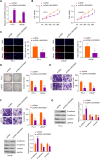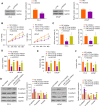LINC00893 inhibits the progression of prostate cancer through miR-3173-5p/SOCS3/JAK2/STAT3 pathway
- PMID: 35818076
- PMCID: PMC9275192
- DOI: 10.1186/s12935-022-02637-4
LINC00893 inhibits the progression of prostate cancer through miR-3173-5p/SOCS3/JAK2/STAT3 pathway
Abstract
Background: Prostate cancer (PCa) is one of the most common malignant tumors in the male urinary system. In recent years, the morbidity and mortality of PCa have been increasing due to the limited effects of existing treatment strategies. Long non-coding RNA (lncRNA) LINC00893 was reported to inhibit the proliferation and metastasis of papillary thyroid cancer cells, but its role in PCa has not been reported. This study aims to investigate the role and underlying mechanism of LINC00893 in regulating the progression of PCa cells.
Methods: We first compared LINC00893 expression levels between PCa tissues and normal prostate tissues through TCGA database. The relative LINC00893 expression levels were further validated in 66 pairs of PCa tissues and para-cancerous normal tissues, as well as in PCa cell lines. Gain-of-function experiment was performed by transfecting PCa cell with LINC00893 expression vector, and CCK (Cell count kit)-8, 5-Ethynyl-2'-deoxyuridine (EdU) incorporation, colony information and transwell assays were conducted to assess the functional phenotypes. Dual-luciferase reporter, RNA-binding protein immunoprecipitation (RIP) and RNA pull-down assays were performed to evaluate the molecular interactions.
Results: LINC00893 was downregulated in PCa tissues and cell lines, and patients with low expression of LINC00893 were associated with a poorer overall survival rate. LINC00893 overexpression hindered the proliferation, epithelial-mesenchymal transition (EMT) as well as the migratory ability of PCa cells, and suppressed the tumorigenesis of PCa cells in nude mice. We further demonstrated that LINC00893 acted as a sponge for miR-3173-5p and inhibited its activity, which in turn regulated the suppressor of cytokine signaling 3 (SOCS3)/Janus Kinase 2 (JAK2)/signal transducer and activator of transcription 3 (STAT3) signaling axis.
Conclusions: Our study demonstrated that LINC00893 suppresses the progression of PCa cells through targeting miR-3173-5p/SOCS3/JAK2/STAT3 axis. Our data uncovers a novel tumor-suppressor role of LINC00893 in PCa, which may serve as a potential strategy for targeted therapy in PCa.
Keywords: JAK2/STAT3 signaling pathway; LINC00893; Prostate cancer; SOCS3; miR-3173-5p.
© 2022. The Author(s).
Conflict of interest statement
The authors declare no conflict of interests.
Figures








Similar articles
-
CircLRP6 contributes to prostate cancer growth and metastasis by binding to miR-330-5p to up-regulate NRBP1.World J Surg Oncol. 2021 Jun 22;19(1):184. doi: 10.1186/s12957-021-02287-2. World J Surg Oncol. 2021. PMID: 34158077 Free PMC article.
-
Overexpressed lncRNA LINC00893 Suppresses Progression of Colon Cancer by Binding with miR-146b-3p to Upregulate PRSS8.J Oncol. 2022 May 5;2022:8002318. doi: 10.1155/2022/8002318. eCollection 2022. J Oncol. 2022. PMID: 35571488 Free PMC article.
-
Piperlongumine inhibits the progression of osteosarcoma by downregulating the SOCS3/JAK2/STAT3 pathway via miR-30d-5p.Life Sci. 2021 Jul 15;277:119501. doi: 10.1016/j.lfs.2021.119501. Epub 2021 Apr 15. Life Sci. 2021. PMID: 33862108
-
STAT3 activates the transcription of lncRNA NR2F1-AS1 to promote the progression of melanoma via regulating the miR-493-5p/GOLM1 axis.J Gene Med. 2021 Jul;23(7):e3338. doi: 10.1002/jgm.3338. Epub 2021 Apr 27. J Gene Med. 2021. PMID: 33822440
-
miRNA-221-3p derived from M2-polarized tumor-associated macrophage exosomes aggravates the growth and metastasis of osteosarcoma through SOCS3/JAK2/STAT3 axis.Aging (Albany NY). 2021 Aug 13;13(15):19760-19775. doi: 10.18632/aging.203388. Epub 2021 Aug 13. Aging (Albany NY). 2021. PMID: 34388111 Free PMC article.
Cited by
-
Circ_0003356 suppresses gastric cancer growth through targeting the miR-668-3p/SOCS3 axis.World J Gastrointest Oncol. 2023 May 15;15(5):787-809. doi: 10.4251/wjgo.v15.i5.787. World J Gastrointest Oncol. 2023. PMID: 37275445 Free PMC article.
-
Ring-finger protein RNF126 promotes prostate cancer progression via regulation of MBNL1.Sci Rep. 2025 Jul 4;15(1):23847. doi: 10.1038/s41598-025-04629-6. Sci Rep. 2025. PMID: 40615482 Free PMC article.
-
Importance of long non-coding RNAs in the pathogenesis, diagnosis, and treatment of prostate cancer.Front Oncol. 2023 Mar 21;13:1123101. doi: 10.3389/fonc.2023.1123101. eCollection 2023. Front Oncol. 2023. PMID: 37025585 Free PMC article. Review.
-
Molecular panorama of therapy resistance in prostate cancer: a pre-clinical and bioinformatics analysis for clinical translation.Cancer Metastasis Rev. 2024 Mar;43(1):229-260. doi: 10.1007/s10555-024-10168-9. Epub 2024 Feb 19. Cancer Metastasis Rev. 2024. PMID: 38374496 Review.
-
Exploring novel furochochicine derivatives as promising JAK2 inhibitors in HeLa cells: Integrating docking, QSAR-ML, MD simulations, and experiments.Comput Struct Biotechnol J. 2025 Aug 8;27:3625-3639. doi: 10.1016/j.csbj.2025.08.007. eCollection 2025. Comput Struct Biotechnol J. 2025. PMID: 40895287 Free PMC article.
References
-
- Gomella LG. Prostate Cancer Statistics: Anything You Want Them To Be. Can J Urol. 2017;24(1):8603–8604. - PubMed
LinkOut - more resources
Full Text Sources
Miscellaneous

